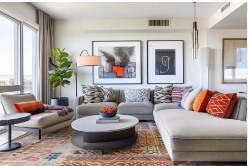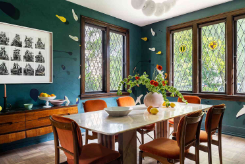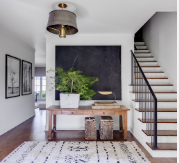Selecting the perfect rug size for your space can transform a room adding warmth, defining areas, and tying your decor together. However, choosing the wrong size can lead to a disjointed or cramped look. This comprehensive guide will walk you through all the tips and tricks for picking the Right Rug Size for Every Room in your home. By the end of this article, you’ll have the confidence to make an informed decision that elevates your space.
Why Rug Size Matters
The size of your rug impacts both the functionality and aesthetics of a room. A well-sized rug can:
- Create balance and harmony within a space.
- Define zones in open-plan layouts.
- Provide comfort underfoot.
- Protect flooring in high-traffic areas.
On the other hand, a rug that’s too small or too large can make a room feel awkward or unfinished.
Rug Sizes for Every Room
The living room is often the centerpiece of the home, and a well-chosen rug can anchor your seating arrangement beautifully.
Living Room

Tips for Choosing the Right Size:
- All Furniture On: Opt for a rug large enough to accommodate all your furniture, leaving at least 8-12 inches of floor space around the edges. This works well for spacious rooms.
- Front Legs On: For smaller spaces, a rug that fits under the front legs of your sofa and chairs can still create a cohesive look.
- Floating Rug: In compact or minimalist designs, a smaller rug placed centrally under a coffee table can add focus without overwhelming the room.
Standard Rug Sizes:
- 8’ x 10’ (ideal for medium-sized living rooms)
- 9’ x 12’ (great for larger layouts)
- 5’ x 7’ (best for smaller seating areas)
Dining Room

In the dining room, your rug should provide a functional and aesthetic base for your dining table and chairs.
Tips for Choosing the Right Size:
Ensure the rug extends at least 24 inches beyond the edge of the table on all sides. This allows chairs to remain on the rug even when pulled out.
Avoid rugs with thick piles, as they can make chair movement difficult.
Standard Rug Sizes:
- 8’ x 10’ (for 4-6 seater tables)
- 9’ x 12’ (for 6-8 seater tables)
- Custom sizes for larger dining sets
Bedroom

A rug in the bedroom adds softness underfoot and enhances the room’s cozy ambiance.
Tips for Choosing the Right Size:
- Under the Bed: A rug that extends at least 18-24 inches beyond the sides and foot of the bed works best. For larger beds, consider a larger rug to maintain proportions.
- Runners: Use runners on either side of the bed for a practical yet stylish option in smaller bedrooms.
Standard Rug Sizes:
- 6’ x 9’ (for queen beds)
- 8’ x 10’ or 9’ x 12’ (for king beds)
- Runners: 2.5’ x 8’
Kitchen

In the kitchen, rugs should balance style and practicality.
Tips for Choosing the Right Size:
- Place a runner along the length of your galley or island to add comfort and warmth.
- Use small area rugs in front of the sink or stove for cushioning underfoot.
Standard Rug Sizes:
- 2’ x 3’ (sink area)
- 2.5’ x 8’ (runners for galley kitchens)
Entryway

The entryway sets the tone for your home and benefits from a durable and appropriately sized rug.
Tips for Choosing the Right Size:
- Ensure the rug fits within the entryway while leaving a border of visible floor space.
- Opt for materials that can withstand heavy foot traffic and are easy to clean.
Standard Rug Sizes:
- 3’ x 5’ (for small foyers)
- 4’ x 6’ or runners (for larger or narrow spaces)
Pro Tips for Choosing the Right Rug Size
- Measure Before You Buy: Use painter’s tape to outline the dimensions of a potential rug on your floor.
- Consider Room Proportions: A rug that’s too small will make a room feel disjointed, while an oversized rug can overwhelm the space.
- Think Layering: Layering smaller rugs over larger, neutral ones is a trendy way to add texture and interest.
- Account for Door Clearance: Ensure doors can open and close smoothly over the rug.
- Material Matters: High-traffic areas benefit from durable materials like wool or synthetic blends.
Rug Placement Guidelines
Do’s:
- Center the rug under key furniture pieces.
- Leave equal amounts of exposed flooring on all sides for balance.
- Use rug pads to prevent slipping and extend the rug’s lifespan.
Don’ts:
- Avoid rugs that are too small for the space.
- Don’t neglect the pile height thicker rugs may not work under furniture with low clearance.
Conclusion
Choosing the right rug size is an art that combines practicality with aesthetics. By following these tips and tricks, you can select rugs that not only complement your decor but also enhance the functionality and ambiance of each room. Whether you’re furnishing a cozy bedroom or an expansive living area, the right rug will anchor your space and elevate its style.

